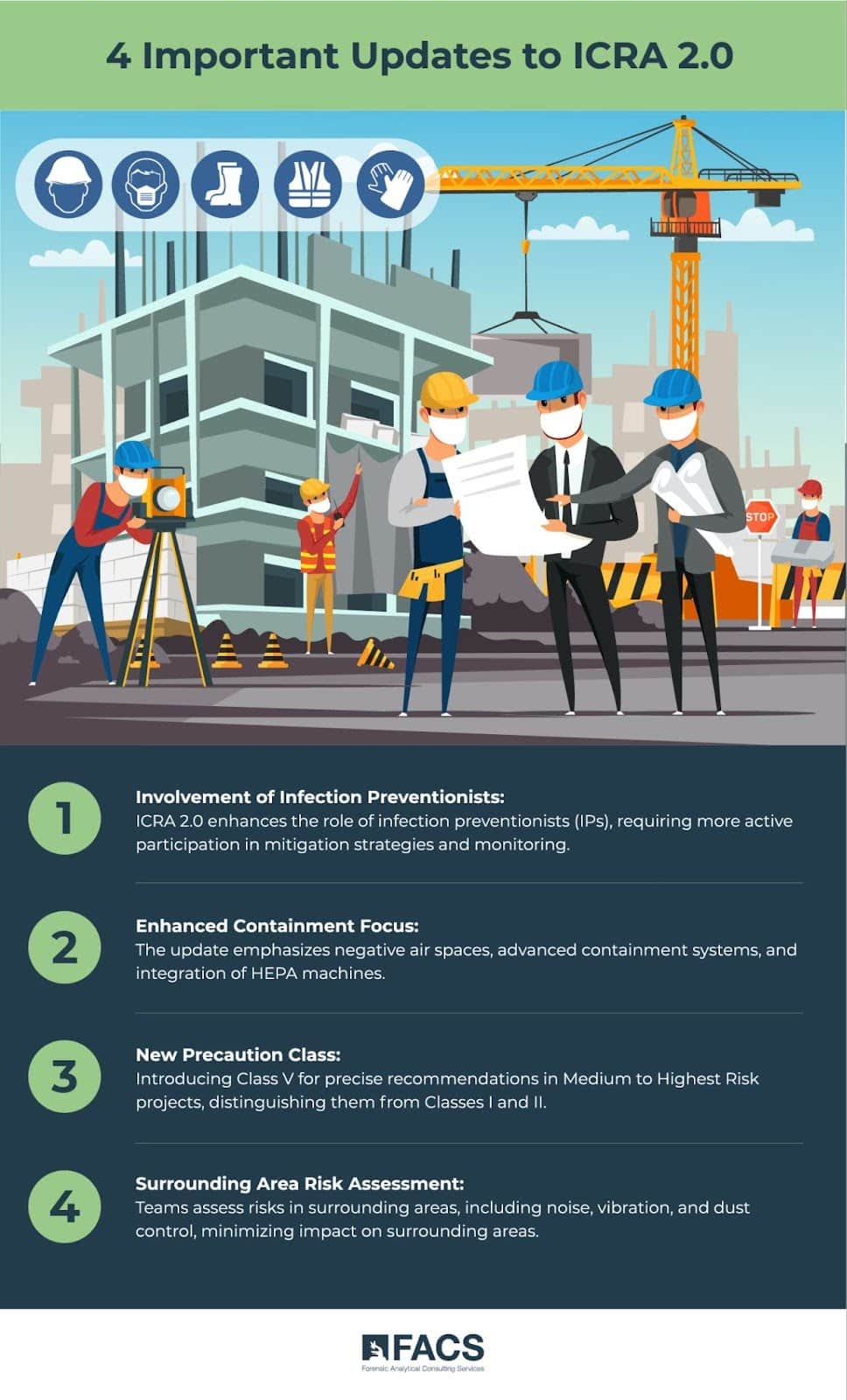Infection control risk assessment (ICRA) guidelines clarify the need for careful assessments of construction project activity at healthcare facilities. The ICRA guidelines are not a set of burdensome rules. They provide a framework that can help you navigate the healthcare construction process.
Healthcare construction and renovation projects tend to be more strategically demanding than other types of construction jobs. Regulations are stringent; infection control is always a concern, and human safety is at the forefront of strategic considerations when a healthcare facility is involved.
In this article, we’ll list several of the latest changes to ICRA 2.0 and suggest ways the updated guidelines can help keep your healthcare construction project on track and your people safe.
Healthcare Construction Projects and ICRA 2.0
ICRA 2.0, the updated infection control risk assessment by the American Society for Healthcare Engineering (ASHE), introduced several significant changes to healthcare facility construction guidelines. These updates aim to bring an interdisciplinary focus to the enhanced need for infection prevention in healthcare facilities during construction, renovation, and maintenance activities.

We find these four changes especially noteworthy:
- Infection Prevention and Involvement of Infection Preventionists: ICRA 2.0 emphasizes the role of IPs (infection preventionists) in the process. IPs are now expected to be more actively involved in dictating mitigation strategies, EPA verification, and monitoring, thereby playing a more hands-on role in infection control during construction activities.
- Enhanced Focus on Containment: The update puts a spotlight on creating negative air spaces and using advanced containment systems for healthcare construction. These solutions include the integration of HEPA machines and pressure monitoring to ensure compliance with ICRA standards and reduce risks associated with fire and smoke.
- New Class of Precautions: A fifth class of precautions has been added to reduce overlap between existing classes, offering more precise recommendations for transitioning from Medium to Highest Risk projects. Renovation and construction projects are now placed in Classes III-V, distinguishing them from standard practice procedures (Classes I and II) which involve minimal precautions.
- Risk Assessment in Surrounding Areas: A new step guides teams to assess risks in surrounding areas, including noise, vibration, and dust control, to minimize impact on areas not being directly worked on.
Adherence to the ICRA 2.0 guidelines can not only help ensure healthcare construction projects get the careful attention they deserve, but your compliance with the ICRA 2.0 guidelines can help defend your facility against any legal challenges arising from the project.
At FACS, we’ve found there are two components that are critical to the success of a healthcare construction project: selecting the project management team and creating the strategy for monitoring the project to ensure control metrics are set and met.
The Healthcare Construction Team
When construction or remodeling projects are underway at a healthcare facility, there is plenty to consider. At the forefront is the protection of patients, staff, and visitors. The ideal construction management team will necessarily be multidisciplinary. The best teams combine expertise from various disciplines to ensure all bases are covered.
Here are examples of the types of knowledge required:
- Infection control
- Risk mitigation
- Evaluations and monitoring
- Facility engineering
- Project management and contracting
- Architect and design
- Industrial hygiene
Issues faced include air quality, infection control, noise, vibration, utilities, documentation, monitoring, communications, and more. The more capable your team of covering all the bases, the more likely you are to navigate the construction process without suffering unforeseen problems.
Healthcare Construction Monitoring
Prior to ICRA 2.0, healthcare construction monitoring focused on dust created by the activities. ICRA 2.0 clarifies the concern about including vibration and noise in surrounding areas. There are a variety of methods available to validate control measures, but FACS recommends you use a certain type of technology: direct reading instruments.
Here is a partial list of why FACS uses and recommends direct reading instruments for healthcare construction or renovation projects:
- They provide real-time monitoring data and help decisions get made rapidly
- They enable point source location monitoring to locate origins precisely
- They deliver the accuracy and preciseness needed in healthcare construction settings
- Data logging is an available option and can help with regulatory compliance
Note that monitoring and data collection should be implemented pre-construction, during construction, and post-construction.
FACS can assist in guiding you with your healthcare construction or renovation project. Get FACS involved at the idea stage, and you’ll gain the benefit of decades of science-backed experience. We can help you gather the right management team, be on hand to monitor the environmental impact of the work, document the findings, and follow up post-construction to ensure a smooth transition through each stage of the work.
For assistance from FACS with your healthcare construction project, use the online contact form or call to speak with a FACS team member at (888) 711-9998.
Case Study: Hospital Construction Project Requires Environmental Monitoring